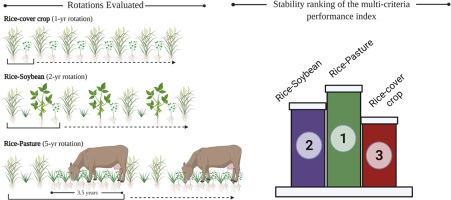Agricultural Systems ( IF 6.1 ) Pub Date : 2022-08-30 , DOI: 10.1016/j.agsy.2022.103488 Ignacio Macedo , Alvaro Roel , José Ignacio Velazco , Alexander Bordagorri , José A. Terra , Cameron M. Pittelkow

|
CONTEXT
Integrated crop-livestock systems are facing the pressure to intensify worldwide, yet decoupling crops and livestock can lead to specialized systems relying on greater external inputs and potential negative externalities.
OBJECTIVE
Our goal was to compare rice-pasture, as the business-as-usual rotation, with two intensified systems, rice-soybean and rice-cover crop, to address the following objectives: 1) quantify partial carbon footprint (CF) including both crop and livestock, 2) develop a multi-criteria performance index based on productivity, economic, and environmental indicators at the systems-level, and 3) evaluate the stability of this index over the study period.
METHODS
To understand how increasing the frequency of annual grain crops influences whole-system sustainability, we evaluated 10 productivity, economic and environmental indicators as well as a multi-criteria performance index and its stability in three rice-based rotation systems over 7 years in Uruguay. Treatments were: (a) rice–pasture [a 5 yr rotation of rice–ryegrass (Lolium multiflorum Lam.)–rice, then 3.5 yr of a perennial mixture of tall fescue (Festuca arundinacea Schreb.), white clover (Trifolium repens L.), and birdsfoot trefoil (Lotus corniculatus L.)], (b) rice–soybean [a 2-yr rotation of rice–ryegrass–soybean (Glycine max [L.] Merr.)– Egyptian clover (Trifolium alexandrinum L.)], and (c) rice–cover crop (an annual rotation of rice–Egyptian clover).
RESULTS AND CONCLUSIONS
Rice-soybean had medium productivity and energy use, resulting in the highest nitrogen and energy use efficiency and among the lowest yield-scaled C footprint. Field greenhouse gas emissions and embodied energy in fuel and agrochemicals were similar in rice-pasture and rice-soybean, but the increase in soil organic carbon in pasture rotating with rice was able to offset this by almost 50%. Rice-cover crop had the highest economic incomes but also the highest input costs, translating into the lowest gross margin. Although the rice-soybean and rice-pasture had a similar gross margin, the variability in rice-pasture was lower and with lower input costs. Rice-soybean and rice-pasture had a multi-criteria performance index 65% higher than rice-cover crop (0.35). Rice-pasture had the highest overall stability across four different stability parameters calculated. We conclude that the intensification of rice-pasture with annual crops could reduce the stability of sustainability without increasing economic performance, even for rice-soybean that showed the best the multi-criteria performance but with less stability across indicators.
SIGNIFICANCE
The findings of this study demonstrate how the integration of rice and pastures with livestock achieves the best combination of stability across profitability and environmental performance, thus mitigating vulnerability to external stressors.
中文翻译:

加强稻草轮作和一年生作物会降低生产力、经济和环境指标的可持续性稳定性
语境
作物-畜牧业综合系统在全球范围内面临着加强的压力,但作物和畜牧业的脱钩可能会导致专业化系统依赖更多的外部投入和潜在的负面外部性。
客观的
我们的目标是比较水稻-牧场(作为常规轮作)与水稻-大豆和水稻覆盖作物两种强化系统,以实现以下目标:1)量化包括两种作物的部分碳足迹(CF)和畜牧业,2) 根据系统层面的生产力、经济和环境指标制定多标准绩效指数,以及 3) 评估该指数在研究期间的稳定性。
方法
为了了解增加一年生粮食作物的频率如何影响整个系统的可持续性,我们评估了乌拉圭 7 年内三个以水稻为基础的轮作系统的 10 项生产力、经济和环境指标以及多标准绩效指数及其稳定性。处理方法是:(a) 水稻-牧场 [水稻-黑麦草 ( Lolium multiflorum Lam.)-水稻 5 年轮作,然后是高羊茅 ( Festuca arundinacea Schreb.)、白三叶草 ( Trifolium repens L )的多年生混合物 3.5 年.) 和鸟脚三叶草 ( Lotus corniculatus L.)], (b) 水稻-大豆 [水稻-黑麦草-大豆 2 年轮作 ( Glycine max [L.] Merr.)-埃及三叶草 ( Trifolium alexandrinum )L.)],和 (c) 水稻-覆盖作物(水稻-埃及三叶草的年度轮作)。
结果和结论
大米-大豆具有中等的生产力和能源使用,导致氮和能源使用效率最高,并且在产量规模的碳足迹中最低。稻田和稻田大豆的田间温室气体排放和燃料和农用化学品中的隐含能源相似,但稻田轮作中土壤有机碳的增加能够抵消近 50% 的影响。水稻覆盖作物的经济收入最高,但投入成本最高,因此毛利率最低。虽然水稻-大豆和水稻-牧草的毛利率相似,但水稻-牧草的可变性较低,投入成本较低。水稻-大豆和水稻-牧草的多指标表现指数比水稻覆盖作物(0.35)高65%。在计算的四个不同的稳定性参数中,稻草具有最高的整体稳定性。我们得出的结论是,一年生作物的稻草集约化可能会降低可持续性的稳定性,而不会提高经济绩效,即使是在多标准表现最好但各指标稳定性较差的水稻-大豆中也是如此。
意义
本研究的结果表明,水稻和牧场与牲畜的整合如何实现盈利能力和环境绩效的最佳稳定性组合,从而减轻对外部压力源的脆弱性。











































 京公网安备 11010802027423号
京公网安备 11010802027423号